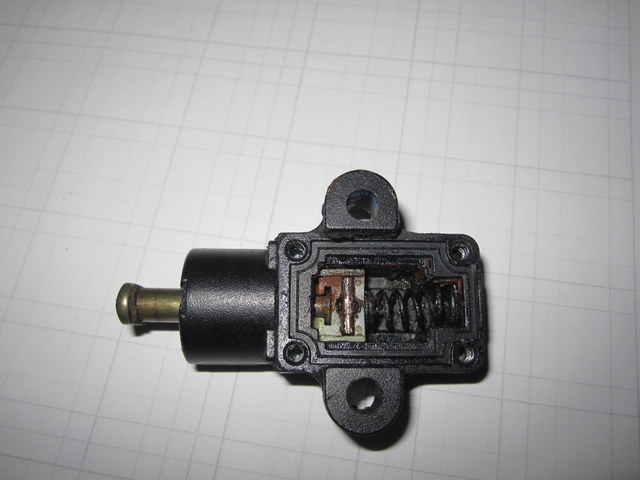So, yesterday my son and I were out for a short ride. After leaving a store turning onto a 4 lane road, I hit the gas to squirt around a slow cager so I wouldn't get stuck behind him at the next light. All of a sudden the bike went dead - no power, just as if you hit the kill switch or something. I pulled in the clutch and coasted into another business' drive way and tried to restart the bike. No joy. I put the bike in neutral and it started back up, but as soon as I shifted into first gear, it promptly cut out again. Doesn't take a rocket scientist at this point to figure out there is something wrong with the sidestand safety switch.
I fiddled around with the sidestand a bit and got the bike to light up and stay running in gear. I rode it gingerly home without further incident. My middle son was home sick today, and being self employed, I drew 'Mr. Mom' duty. After making sure he was OK for a while, I dug into the sideswitch problem.
For those who haven't had to deal with this yet, the simplest way to get at it (at least on Gen I models - I can't speak for Gen II) is to remove the two 6 mm allen head cap screws that hold the kickstand on. When these are removed, the kickstand slides down and you can rotate it around for easy access to the screws that hold the sidestand switch onto the kickstand frame. (BTW - I rounded the phillips head on these pretty easily and ended up replacing them with new stainless steel screws). There are then 4 small phillips screws holding the back plate of the switch on. I removed these and left the backplate hanging on the bike - the wires are soldered in place and there is no need to remove it further.
After removing the switch, I was surprised to see so much moisture inside! :blink:

I thoroughly cleaned all the inside parts. The spring was so corroded that it broke when I removed it. After cleaning the inside of the switch, I reassembled it, and I added a small shim behind the copper bar that completes the connection when the kickstand is up. It looked like it was almost flush with the plastic carrier and I wanted to make sure that it would make good contact with the two connectors on the back plate. I lubed the moving parts with dielectric grease and reassembled the switch.
The repair was successful and I (hopefully) won't have any more power losses like that again.
For those of you who are like me and live by the mantra "If you don't ride in the rain, you don't really ride" (which is, I suspect, most of you), it may be worth while to take a closer look at your sidestand switch to avoid the same problems I had.
I fiddled around with the sidestand a bit and got the bike to light up and stay running in gear. I rode it gingerly home without further incident. My middle son was home sick today, and being self employed, I drew 'Mr. Mom' duty. After making sure he was OK for a while, I dug into the sideswitch problem.
For those who haven't had to deal with this yet, the simplest way to get at it (at least on Gen I models - I can't speak for Gen II) is to remove the two 6 mm allen head cap screws that hold the kickstand on. When these are removed, the kickstand slides down and you can rotate it around for easy access to the screws that hold the sidestand switch onto the kickstand frame. (BTW - I rounded the phillips head on these pretty easily and ended up replacing them with new stainless steel screws). There are then 4 small phillips screws holding the back plate of the switch on. I removed these and left the backplate hanging on the bike - the wires are soldered in place and there is no need to remove it further.
After removing the switch, I was surprised to see so much moisture inside! :blink:

I thoroughly cleaned all the inside parts. The spring was so corroded that it broke when I removed it. After cleaning the inside of the switch, I reassembled it, and I added a small shim behind the copper bar that completes the connection when the kickstand is up. It looked like it was almost flush with the plastic carrier and I wanted to make sure that it would make good contact with the two connectors on the back plate. I lubed the moving parts with dielectric grease and reassembled the switch.
The repair was successful and I (hopefully) won't have any more power losses like that again.
For those of you who are like me and live by the mantra "If you don't ride in the rain, you don't really ride" (which is, I suspect, most of you), it may be worth while to take a closer look at your sidestand switch to avoid the same problems I had.






























































